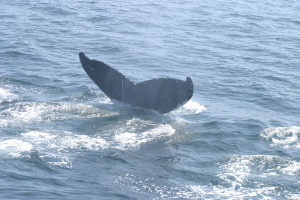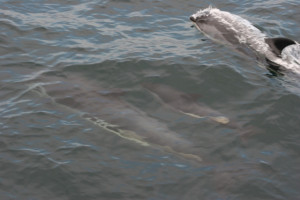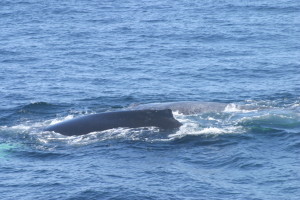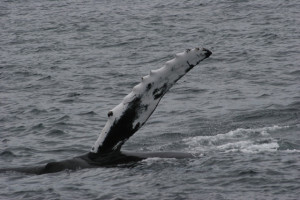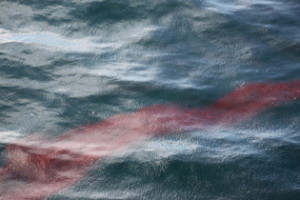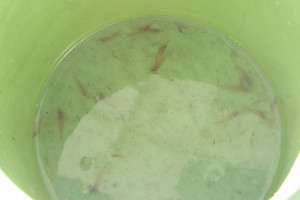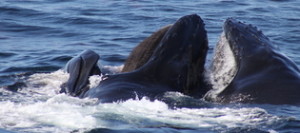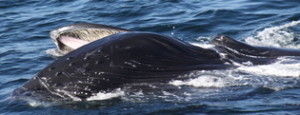Dolphin Fleet Naturalist Notebook 22 August to 28 August
August 22nd: With all of the news of Hurricane Bill brewing off-shore, only 73 people were brave enough to come aboard the morning trip on the Portuguese Princess II. Although the wave height was under three feet, we could feel the swell slowly building throughout the trip. We headed eastward, against the swell, and found ourselves traveling alongside Bolide and her calf, as another juvenile hung out nearby. It takes humpback whales about 8-10 years to reach full maturity, so while it is difficult to guess a whale’s exact age just by looking at it, a juvenile will look significantly smaller next to a mature adult humpback such as Bolide.
Throughout the day, we also encountered what has become an unusually tight-knit group. Pele, Canopy, Whisk traveled along the southern portion of the triangle, easily distinguished by the unique patterns on the underside of their flukes. Canopy, for example, has an all-black fluke with a white line down the left fluke.
Canopy
August 23rd: All trips were canceled due to Hurricane Bill.
August 24th: Although the leftover swells from Hurricane Bill were palpable, we decided to try our luck with an off-shore trip, and we headed eastward toward the “Triangle”, an area just east of Stellwagen Bank. We were pleased to find that the high winds and seas hadn’t caused our favorite humpback group to dissipate. Pele, Canopy, Whisk, and Percussion were still embarking on long, exploratory dives, potentially looking for food deep in the water column.
Meanwhile, Echo, a large female first seen in 1988 surprised us all by leaping out of the water on our afternoon trip! On our way back towards shore, we even got an opportunity to see three fin whales at a distance, one of which we identified as a whale named “Spike”, based on the shape of its dorsal fin.
By the evening trip, the seas had been reduced to glassy calm, which is what allowed to us to see small dorsal fins breaking the surface a ways from the boat–the telltale sign of Atlantic white-sided dolphins! As we approached the small pod, some of them swam up alongside the boat, giving us a close look at their yellow and white-striped markings, and even one of their calves!
A dolphin breaks the surface while a mother and calf are visible just below
The glassy conditions of the previous evening held fast into the morning of August 25th and, evidently, so did some of the dolphins. We saw a small pod of 15-20 of them on our first trip out to the Triangle. Later in the morning, we came across humpback mother and calf pair that we hadn’t seen since the beginning of the season. Iota, a female born in 1988 was going on long dives, probably feeding near the bottom, while her calf followed close behind. Our location in the southern Gulf of Maine is one of the first places many humpback whale mother and calf pairs stop near the end of their northward migration in the spring. Tired and hungry from their 1, 500 mile journey, female humpbacks can often find plentiful schools of fish to sustain their hearty appetites that have built up during their winter months of scarce food. Many of these mom and calf pairs will continue northward towards destinations off of New Hampshire, Maine, and Canada, while others will remain and feed throughout the summer season.
On August 26th, the deep feeding continued, as humpbacks would fluke up and disappear for a good ten minutes before coming up for a loud exhalation and a sometimes audible, yet very rapid inhale. Hancock, Eruption and Percussion appeared first, while Division, Milkweed, and Division were documented slightly farther to the north. We are making sure to pay special attention to Venom’s behavior and take many pictures of her, as she appears to be in potentially ill-health.
Healthy humpbacks have dark, smooth, skin, although they may carry barnacles, or have small scratches and sometimes scars. Venom, on the other hand, seems to have developed very gray, slightly blemished skin since we saw her last summer. In many species of whales, skin condition and color can be an accurate indicator of overall health. We don’t know exactly what is wrong with this mature humpback, but some suggest that perhaps she sustained some sort of injury or contracted an infection. In the photo below, notice the contrast between the dark, healthy humpback, and the gray, slightly emaciated humpback.
In the afternoon, a return trip to the Triangle saw many of the same animals as the morning, though the naturalist noted that the groups had started to break up and spread out. This is typical of the small, unstable groups that humpbacks tend to form. The trip ended on a spectacular note as Spirit, a two year old humpback breached, lobtailed, and slapped its flipper on the water.
After a relatively low-key trip to the Triangle on the morning of August 27th, we decided to head up to Stellwagen Bank in the afternoon to check out the conditions further north. Was it ever worth it! Upon arriving, we noticed that the water was thick with krill. Krill are small, shrimp-like crustaceans, reddish in color to the point that large concentrations of them make the water appear crimson.
A band of krill in the water
Krill captured in a plankton tow
While krill is an important source of food for baleen whales all over the world, the humpbacks in our area tend to feed primarily on small fish, like the sand eel. When humpbacks feed on sand eels, they try to concentrate the fish into mouth-sized aggregations by blowing rings of bubbles or kicking their tails in order to stun and confuse the fish. When we see them pursue krill, they tend to execute speedy side lunges, their ventral plates expanding and billowing to accomodate the hundreds of gallons of food and water they take in with every mouthful.
Two humpbacks lunge for krill
A humpback’s ventral pleats expand
For almost an hour, we watched as at least twenty humpback whales, including Draco, Pipette, Hancock, Eruption, Ravine, and Cajun burst to the surface, their mouths full of food. Amongst the krill, a school of sand eels fed, while a school of bluefish swam by to feed as well. Gulls, terns, and shearwaters swooped down to snatch up food from the water. The huge variety of species, the dynamic feeding, and the ideal weather made this one of the most exciting trips of the season!
After all of the excitement on the previous afternoon, we were hoping for more of the same on August 28th. While the feeding frenzy had largely subsided, we did see some of the same humpback individuals, including Ravine and Eruption, resuming their long, deep dives so indicative of bottom feeding. Canopy, on the other hand, was a bit more active, and we were delighted to watch her breach and lobtail before we headed back to shore.
After venturing to the southwest corner of Stellwagen on the morning trip, the Portuguese Princess II headed to the east in the afternoon. With the bluffs of Truro as a backdrop, we watched as two groups of humpbacks fluked and dove repeatedly. We thought the groups would join up, but the groups never merged and instead went their separate ways.
Just as we were about to head for home, a humpback popped up right next to us. We recognized this whale immediately by his large, rounded dorsal fin. It was Colt! Colt is famous for curiously investigating whale watch boats, often to the point where we have trouble leaving! Colt didn’t seem to be in the mood for a sustained close boat approach today, but it is always a treat to get to see this well-known humpback.
On the way back in to shore, we saw a Minke whale quickly pop up just as we were passing Herring Cove – a reminder that it is possible to see exciting wildlife at any point during our whale watch trips! As we monitor the weather, listening for clues as to when the next hurricane will pass, we hope that next week will be as exciting and dynamic as this one!






